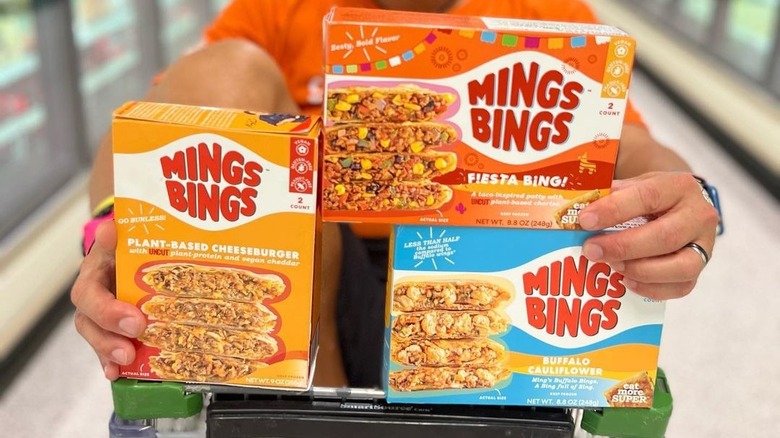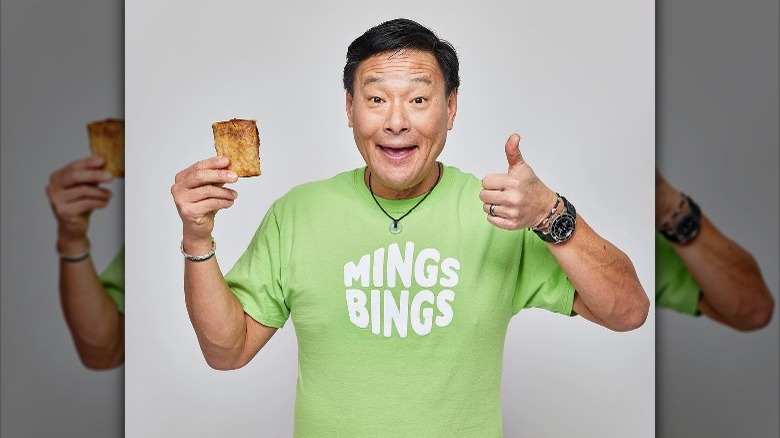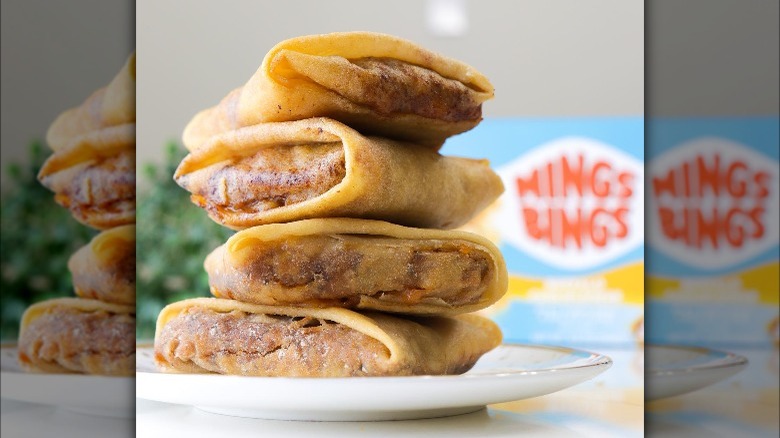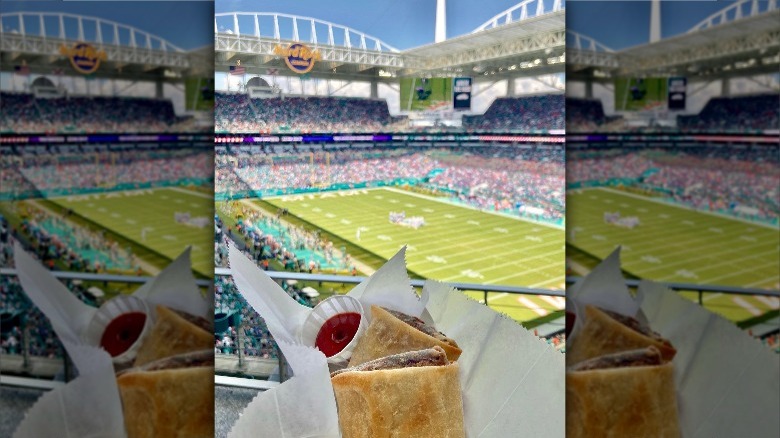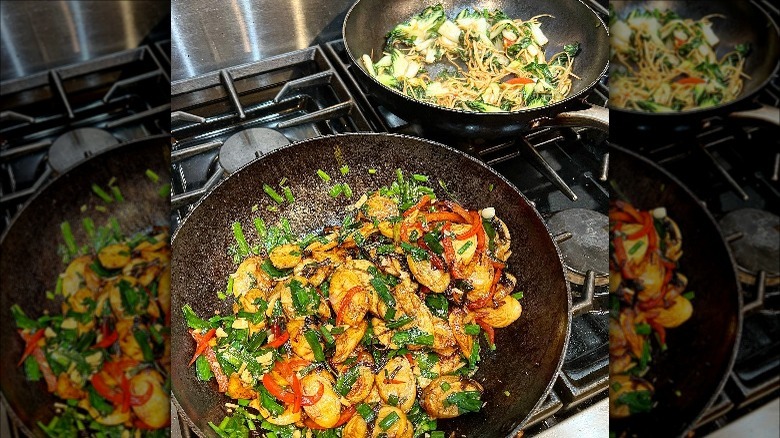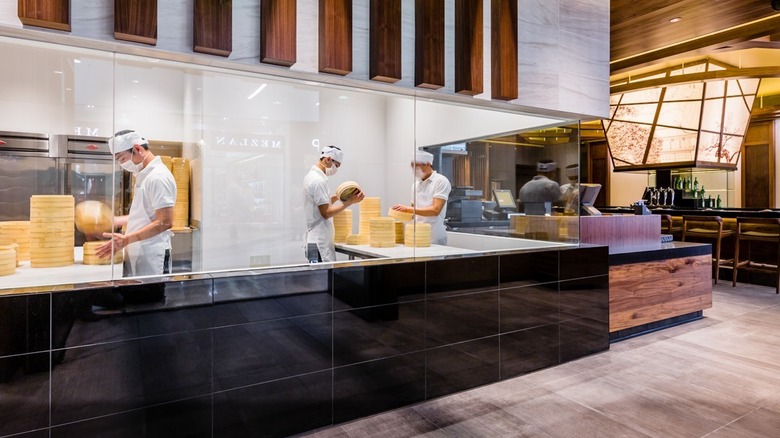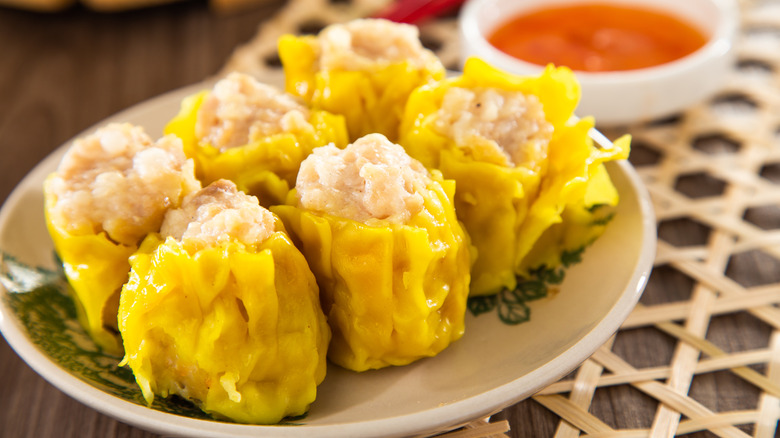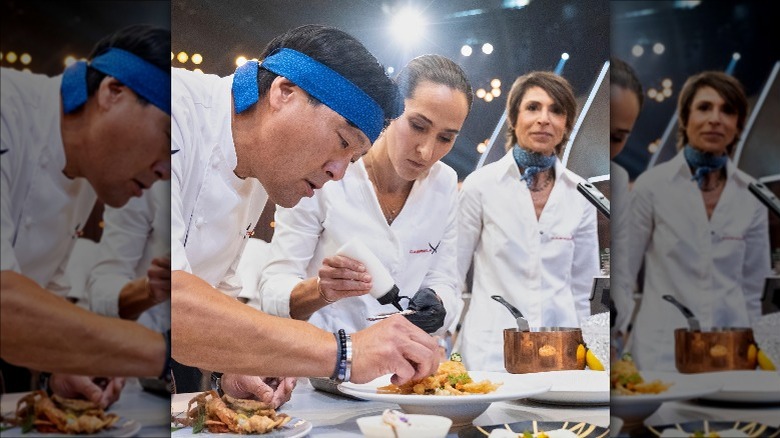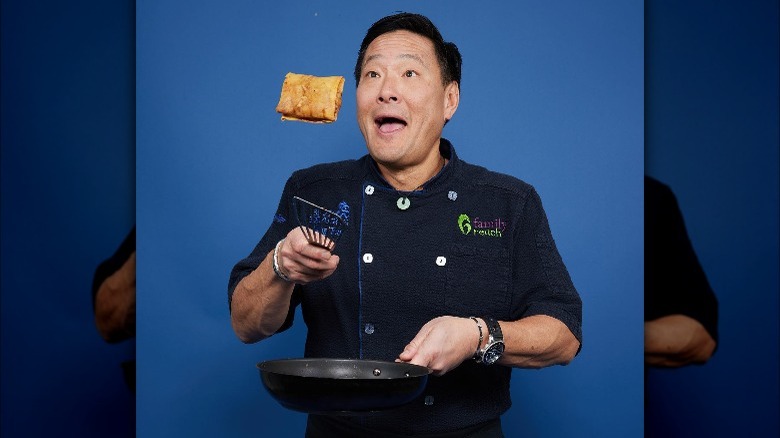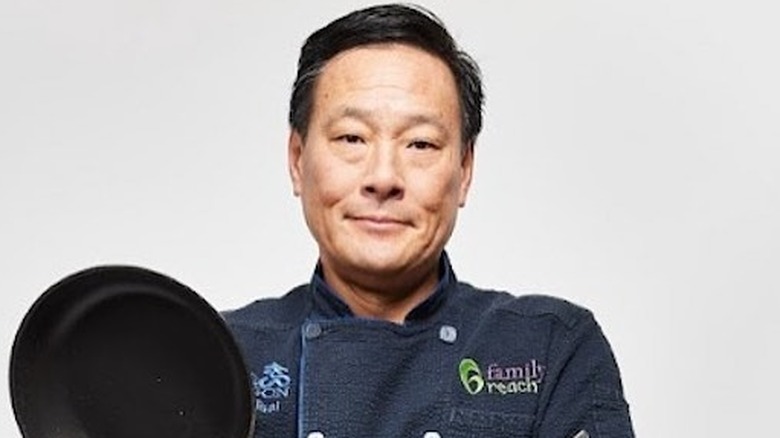How Iron Chef Ming Tsai Creates East-West Cuisine With A Purpose - Exclusive Interview
If you love the flavor fusions that happen when you mix Asian ingredients with Western concepts, then you have Ming Tsai to thank for it. The celebrity chef, cookbook author, TV host, restaurateur, and business owner has built a decades-long culinary career championing his signature East-West cuisine. Tsai's approach in the kitchen proves that when you bring together global influences and think outside the box to find harmony on a plate, some pretty delicious things can happen. That attitude, combined with some exceptional cooking skills, is how Tsai became an Iron Chef, James Beard Award recipient, and an Emmy winner, just to name a few accolades.
In recent years, Tsai has devoted his culinary efforts to the masses, introducing MingsBings — a line of plant-based, dim sum-inspired pockets filled with chef-crafted ingredients that are as good for you as they taste. Tsai's turn toward plant-based foods and his goal to make them more accessible is a deeply personal endeavor, and now, the chef is on a mission to show the world that eating more veggies can be a lot more fun and delicious than you might think.
In an exclusive interview with Tasting Table, Tsai opened up about all that and more, and he shared some of his favorite plant-based cooking tips. The chef also looked back on his return to "Iron Chef," his future in the restaurant industry, and how he's continuing to look for ways to grow as a chef and give back along the way.
A medical scare led to the creation of MingsBings
There's some exciting things happening with the MingsBings brand. What inspired you to create this product?
It started basically out of the blue. My wife had a big health scare five and a half years ago, and we made two pretty quick decisions. The first one was easy: Let's go to Dana-Farber Cancer Institute. The second step we decided collectively [was to] go vegan.
The basic premise was to reduce inflammation. Inflammation causes and helps most diseases propagate. Inflammation is [from] gluten, wheat; inflammation comes from all protein, not just beef. It's pork, it's salmon, it's fish, it's chicken, it's everything. Going vegan and going plant-based is a great step toward [reducing] that.
I basically went to the grocery stores [to see], "What can my wife eat when I'm not home?" The veggie patty market — not to disparage any brands, but the popular ones, Boca and Garden and Dr. Praeger's, all of them — they're all like emulsified hockey pucks. They're pureed chickpeas or edamame or whatever. None of them are good.
I decided to flip the paradigm — put the emulsification on the outside. That was probably the trick or the hardest part of MingsBings [was developing] a brown rice wrapper that's gluten-free. Then we decided to fill it with deliciousness. By chefing it up, I added caramelized onions and garlic and ginger and spices and herbs. The only allergen in MingsBings is soybeans. There's no nuts, no peanuts, no gluten, nothing — of course, no meat.
We're so psyched. We've been doing this for three-plus years. We now have nine flavors out there ... We're in 4,000-plus stores, so we're growing and we're psyched.
Our motto is actually "eat good, feel good, do good." "Eat good" because it has to be delicious; I'm an Iron Chef. "Feel good" — plant-based does make you feel a little bit better. It also makes your mind feel a little bit better knowing you're helping the environment a little bit. I don't need to get into details about the thousands of gallons of water it takes to bring a burger to your table. Then, "do good" because some proceeds of all sales benefit Dana-Farber, the hospital that saved my wife's life, and a great charity called Family Reach. We financially help families dealing with cancer.
MingsBings are a plant-based spin on Western favorites inspired by traditional Chinese dim sum
How similar are they to the traditional bings that you'll find in Chinese dim sum?
A bing is a traditional dim sum item on the streets of Beijing and Taiwan. They have all different types of bings. They have char siu, which is a stuffed pork dumpling. They have jian bing, which is something like a folded crepe. Scallion pancake is a type of bing.
They're very similar in the format that you can eat [them] with your hand, that they're juicy, they have a crunch to them. Mine are even crunchier than a classic. Usually, a bing is made with a hot water dough, which is all-purpose flour and boiling water. That's the same dough you make scallion pancakes and potstickers and bings with. But without gluten, you have to change the process. Without gluten, nothing sticks. Gluten-free breads and cookies and things are always so sandy and pasty, and no one ever says, "This is just like the real thing." You never eat a baguette that's gluten-free, like, "This is like in Paris." It's not, sorry.
But one of the best [things about] MingsBings is the crunchiness. It's delicious because I'm an Iron Chef and it's super crunchy. Our secret is you actually have to cook it twice. You have to cook once to make the wrapper, and then the second time you have to crisp it up and seal it.
Getting more into some of these flavors, you've got cheeseburger, sausage and peppers, and other things that do not immediately scream vegan or plant-based.
When I founded MingsBings, I didn't want to go into Asian appetizers. I didn't want to get lost that way. I wanted to stick to my true roots, which is East-West cuisine ... [it's] the blending of techniques and ingredients from both the East and the West. I've always said that it creates a deliciousness first, contrasting textures and temperatures if you can. And at the end of the day, [it's] inherently healthy. I've been saying that for 25 years. This is the way I've always cooked ...
We wanted to do flavors that were recognizable for the American palate. Our cheeseburger is actually our most popular bing ... There is that challenge [with plant-based] because some people are like, "Nope, won't touch it. I'm a real man. I don't do that." We've just got to get them to eat it, because the good news for us right now in our company is that once people try it, they love it.
We've been the official bing of the Boston Red Sox — it's our third year doing this. We sample people. Toward the fifth inning when people are a couple of beers in, [we had] these big men, and they're holding two 16-ounce cans of passionfruit Truly — so it's hard to be like, "I don't eat plant-based." They're holding two Trulys, right? And we say "cheeseburger bing." We don't even say it's plant-based until they bite into it [and say], "These are really good." Then we're like, "Those are plant-based." They're like, "We don't like plant-based [foods]." Well, you actually do; you just ate two of them.
Try MingsBings with their dipping sauces to recreate your fast food favorites
Now you've got the new breakfast line of bings and the dipping sauces.
I love the breakfast bings as much as the savory ones. The chorizo plant-based protein is so good, it actually bleeds the red oil. I love it. The veggie egg and cheese is awesome. I tried every fake egg out there ... JUST Egg hands down is the best scrambled egg. It's made from mung bean.
What are some of your favorite bing and sauce combos that we should try?
The best flavor combination was influenced by In-N-Out. In-N-Out has a double-double animal style, which is their best burger. It has a thousand island — their own dressing. We take our cheeseburger bing and recreate the double-double animal style flavor profile. We've created what's called the 8,000 Island Dipper; I say it's eight times better than thousand island. It is our version of that special sauce In-N-Out has. We put that with pickles and crispy shallots, and when you bite into that, if you close your eyes, you're thinking you're eating a double-double animal style.
My other favorite combo is our chorizo bing — both the fiesta bing and the chorizo egg and cheese — with an avocado lime puree, which literally is two ingredients. I don't want to compare us to Taco Bell, although one day I'd love to be in Taco Bell, but it's [like] that crunch wrap supreme. Everyone that bites it is like, "This is a crunch wrap." I guess we've made it if we're being compared to Taco Bell.
Ming Tsai says awareness and access will help spread the plant-based movement
You mentioned you are in thousands of stores now, but you're also in more sports stadiums and arenas. Are you seeing success there, and why do you think that is?
Universities and stadiums have a need. They have their fan base, and of their fan base, in general, 1-5% are vegans [and] 10-20% like to eat more plant-based. And there's up to 50% of people in this country now [who] have some relationship with gluten.
In these food service establishments, they have a need for vegetarian, but the gluten-free component of MingsBings is what is really the most popular [aspect] about it. The stadiums are so excited to be able to offer something that's delicious, and they're excited that this is actually something that people are now asking for. [People with dietary restrictions] love the fact that they can eat something with their hands as scrumptious as a hotdog and not feel left out because everyone else gets to eat.
For people who don't have allergies or that aren't necessarily restricting their diets, what do you think is the key to making plant-based and vegan eating more a mainstream part of dining culture in this country?
Now that there are delicious plant-based proteins, you can easily cook how you normally cook [and] substitute with plant-based — even stuff as simple as a hamburger.
You can't convert some people — [like] kids — they want a burger. But you can do a better burger by hiding. I make burgers that are two-to-one ratio, burger meat to veg, and cauliflower rice is the secret. Cauliflower rice is a great vegetable with good vitamins, but it has no flavor, so you can bury cauliflower rice. [I use] that and caramelized onions, and I like to add raw onions and put that with your burger. It's a better burger for you, but no one cares about it because it's still just as delicious.
That's the trick, especially with kids. You give kids steamed broccoli or boiled broccoli for the first time with salt and it's mushy. They're going to hate broccoli for a very long time. If you start the pan with garlic and oil, they don't care what is in the pan. Then you put your broccoli and cauliflower and bok choy, [and] they love the veg.
So take care of your veg. Thomas Keller, probably our best chef in this country, famously said, "It is so much harder to make a carrot taste good than an A5 Kobe beef steak." Everyone can make a steak taste good. But to make a carrot sing, you have to chef it up.
How to cook plant-based meals like an Iron Chef
What are your favorite plant-based recipe swaps when you're cooking at home?
Anything that uses ground beef — that's meatloaf, that's a bolognese — is an easy swap.
With vegetables, here's a couple of secrets. There's some really good vegetarian oyster sauces out on the market made with dried mushrooms. That's a stir-fry cheat for that unctuous, deep umami flavor you get in every beef and broccoli and goomba chicken, all these great classic Chinese stir-fries. There's always oyster sauce used. A veggie oyster sauce is a great way to make any stir-fry taste better.
Another trick to make veggies taste good is to think about how to enhance flavor without sodium. There's two ways of doing it. If you use soy sauce versus salt, you're going to get a sweeter, more deep flavor of soy sauce without the same sodium quantity. You can also reduce sodium by using acid. Quite often, I'll use half the amount of sodium that a recipe normally would call for, and I will squeeze a lemon or a lime or splash of vinegar in it. That makes veggies sing.
Then, of course, [pasta with] thick heavy cream sauce is not going to be good for you. [With] good fettuccine alfredo, you could take those same noodles and you could add much more veg to it and still do the garlic stir-fry and the olive oil, and at the end, add herbs. Herbs is the other MSG; fresh basil, fresh parsley, fresh cilantro, fresh mint. That also makes things pop.
No one does dim sum like Din Tai Fung, according to Ming Tsai
Do you have a favorite dim sum spot here in the U.S.?
I'm not usually promoting chains, but there's an amazing restaurant Chinese chain called Din Tai Fung. Their truffle soup dumplings — are you kidding me? To me, they're such a great role model, and they should be for so many restaurateurs because they do one thing so well and they are consistent.
Every soup dumpling I've had — and I've been to probably 10 Din Tai Fungs around the world, including the original one in Taipei, Beijing, Singapore, Shanghai, Seattle, LA — they're always exactly the same. It's remarkable. Talk about science — they had the exact temperature of water to the 10th decimal point in centigrade, the exact grams of flour, exactly 3 minutes and 22 seconds to mix.
The one part they couldn't automize — and no one's figured this out yet — is the rolling of the skin and wrapping of the dumpling because that is so [hands on]. Maybe they'll have robots one day, but they still have those six or eight people doing that.
Then they put them in these stainless steel steamers with four holes. The thing I'd never seen before ... Normally, you put your steamers over a wok and a big burner and steam it for eight minutes. [The chef] took like five steamers stacked up ... and he would push a button and high-pressure steam would shoot through all five of those of the steamer baskets. In exactly six minutes and 22 seconds, perfect soup dumplings.
If you want to make your own dim sum, start with siu mai
What are some dim sum items that you think deserve more recognition here?
Although I do love spring rolls and bings and potstickers ... I love steamed siu mai. I love them because you can make them very ethereal and light with a shrimp mousse or a fish mousse.
Siu mai could have a reemergence or renaissance because you can buy wonton skins anywhere in the country. It doesn't have to be Asian American wonton skins. Then once you make a mousse filling out of any protein, or non-protein ... You can use egg as the binder if you're using a ground meat, add your aromatics and your veg. With dim sum, if you're using ground beef, you can put 50% veg in there because it's going to stick together.
It's not hard to make a siu mai. People think, "How do you do that?" You literally wrap it up, flatten it up, and once you do five of them, you'll be like, "Oh my God, I could be an Iron Chef." They're not that hard.
I love the fact that they're steamed because steaming doesn't heat up the whole house. It's very easy to do. My one tip for the home cook is to put a tea bag or a little handful of tea in your water to steam because water has no flavor and tea does, so you actually taste a little bit of tea flavor in the skin when you use steam with tea.
By the way, that's one of the only dim sums that can do well in a microwave by adding a little water to a covered dish. They're supposed to come out soft and luscious.
Ming Tsai on the return to Iron Chef
What was it like returning to "Iron Chef" last year for "Quest for an Iron Legend"?
Oh my god. All of us chefs grew up watching Morimoto and Kenichi and Sakai, the original "Iron Chef Japan." It was a huge honor to be included in this group with Curtis Stone and Dominique Crenn and Gabriela Camara and Marcus Samuelsson. They're all my buddies, and obviously top chefs of the world, not just the country. That was a huge honor.
By far, bar none, [it's] the hardest thing I've ever done in my life. When it's 60 minutes, it's a true 60 minutes. You literally cannot make a mistake. It is physically grueling. I love that.
What was the hardest challenge for you?
I'll tell you a side note: You actually know three secret ingredients one month out, because they want chefs to have super awesome food. If it literally was blind, and we do 25 plates in 60 minutes having never tried it once, they're going to have good food; they're not going to have spectacular food. The moment it's revealed on TV is the moment we realize what it actually is.
But I had sturgeon, I had dungeness crab, I had scallop. You had to practice that, because if you don't practice, you're not going to do well. A lot of work has to go beforehand.
Then at the moment, it's like Michael Jordan — there's big time plays. Your sous chefs can't screw up; they make one mistake, you're done. I make one mistake, you're done. Because everything is timed. Physically and mentally, it's the hardest thing I've ever done and the most fun I've ever had. You get that incredible adrenaline rush, and you're like, "Oh my God." You're so dead tired after it.
Ming Tsai on his future in the restaurant industry
Do you see yourself opening another restaurant in the future?
In the immediate future, no. I have one restaurant out at Yellowstone Club in Big Sky, Montana, which I love to death. It's an amazing place to be. My wife and I love the mountains, and I'm there four months out of the eight months we're open.
I do see in my future some type of smaller footprint kiosks that can sell bings, in an airport, in a college environment ... Sbarro has their pizza all laid out on the hot stainless steel right in front. You pick a pepperoni — boom, you're done. [I want to do the] same thing — six different flavored bings, six different sauces, unsweetened iced teas.
I do see something like that. A full sit-down type restaurant ... I don't see it in my immediate future. Look, never say never. As my dad and grandfather always preached to me, listen to every opportunity, because you don't know 'til you know. If someone shows up with a big briefcase of cash, you got to listen.
Ming Tsai reflects on his controversial comments and lessons learned
Before I let you go, I want to give you a chance to address the recent headlines that have been circulating around those comments that were made at the WBUR City Space. You've come out and apologized for that. Is there anything else that you want to say about that or the biggest takeaway for you from that whole experience?
I made my apology, and I'm going to stick to that statement. I'm so regretful and sorry. That whole thing happened, and like I said in the apology, I've learned from it. I've moved on and I am being more introspective. I thought I was, but in that moment, it was a bad moment and I apologize for it. I know everything I've done in this world that's been great, and the lives I've saved through the charities and stuff I've done, so I'm sticking to that. I'm glad you can, through actions, show everyone who you are.
Click here to learn more about MingsBings and find a retailer near you.
This interview has been edited for clarity.

